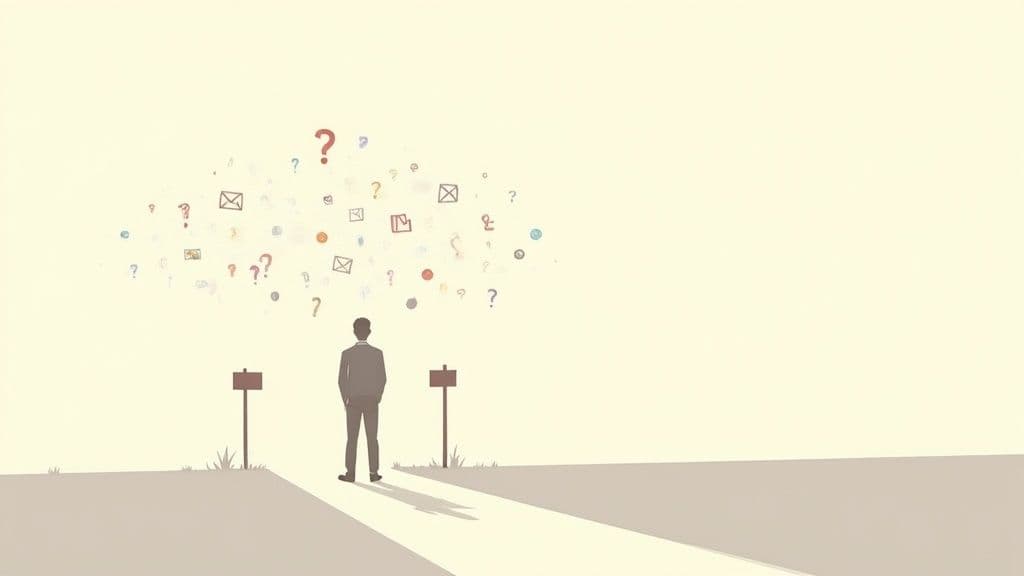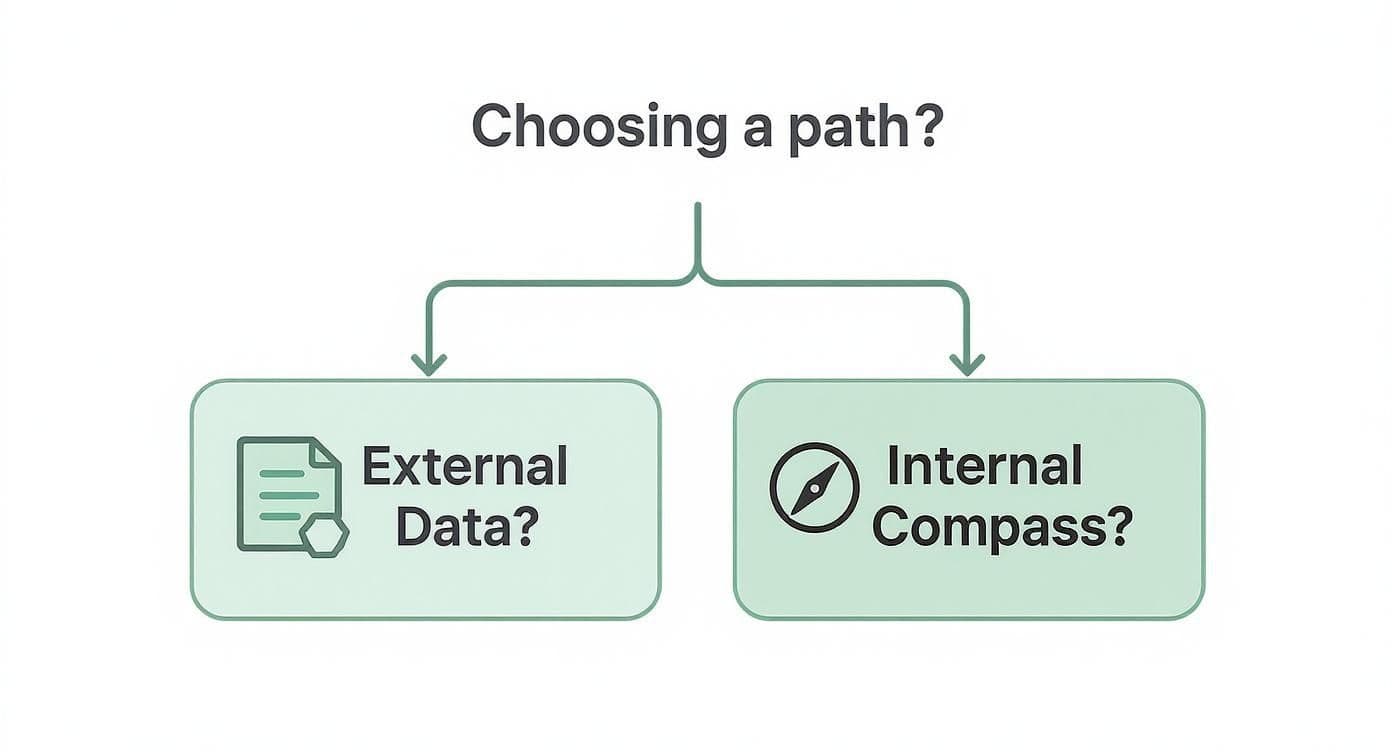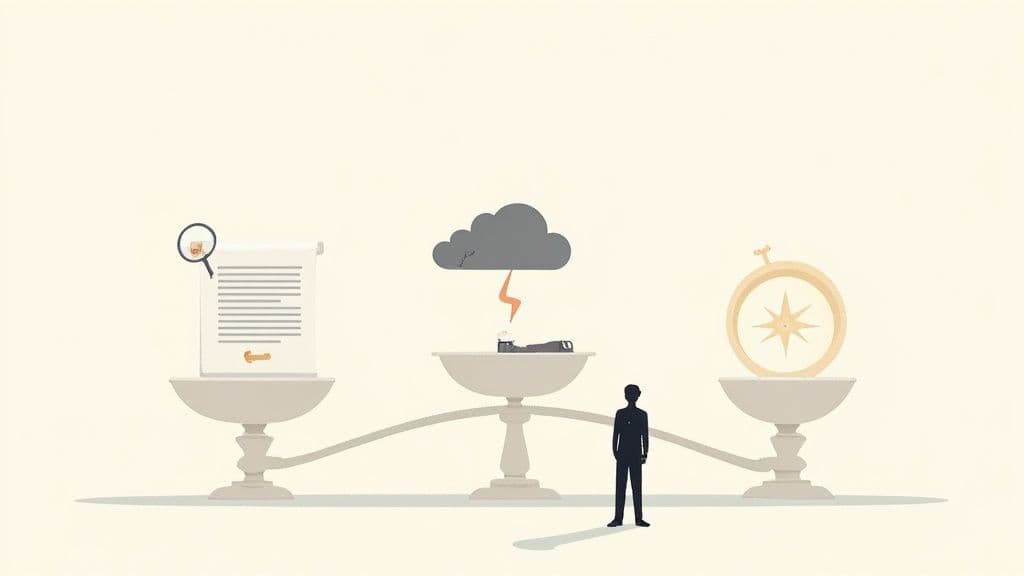Feeling stuck in analysis paralysis? Learn how to overcome indecision with actionable strategies to make clear, confident choices in work and life.
November 8, 2025 (Today)
how to overcome indecision: Steps to decisive living
Feeling stuck in analysis paralysis? Learn how to overcome indecision with actionable strategies to make clear, confident choices in work and life.
← Back to blog
How to Overcome Indecision: 10 Steps to Decide Confidently
Feeling stuck in analysis paralysis? Learn practical, research-backed steps to make clear, confident choices at work and in life.
Introduction
Feeling stuck in analysis paralysis is exhausting. You think more, but you feel less sure. This guide gives clear, actionable tools to break the loop, start making choices faster, and build lasting confidence so decisions feel like progress, not panic.
The first step: act with purpose, not panic
The first step to overcoming indecision is to stop getting lost in endless questions and start taking small, purposeful actions. Shift your focus from every possible outcome to what’s actually holding you back, cut through the noise, and learn to trust your inner compass.
Understanding the roots of indecision

We’ve all faced tiny moments of paralysis—staring at a menu or replaying the same career pros and cons at 2 a.m. Indecision isn’t a character flaw; it’s often a side effect of information overload and internal pressure to be perfect.
Decision distress in the modern world
The constant flood of data creates a form of anxiety I call decision distress. It’s more than feeling overwhelmed; it’s second-guessing and regret after choices. In one global study, 85% of business leaders reported second-guessing or guilt about decisions1. Another survey found 78% felt swamped by information and 86% said that overload made decisions harder at work and home2.
The real problem isn’t a lack of good options. It’s losing touch with what you actually value, so every choice feels like a gamble.
Before we dive into solutions, here are common mental traps that keep people stuck.
Common Indecision Traps and How to Escape Them
| Indecision Trigger | What It Feels Like | A Quick Strategy |
|---|---|---|
| Analysis paralysis | “I need more information before I can decide.” | Set a decision deadline and cap your research. Force a choice with what you have. |
| Fear of regret (FOMO) | “What if the other option was better?” | Reframe toward "good enough" outcomes that move you forward. |
| Perfectionism | “None of these options are perfect.” | Make small, reversible decisions to build momentum. |
Why these traps work
Indecision is often driven by fear and perfectionism. You fear making the wrong choice and expect a flawless outcome. Recognizing these patterns is the first step toward change. Working on limiting beliefs can help you build resilience and self-trust; resources like the Life Purpose App can support that inward work by helping you clarify values and priorities.
Your internal compass: aligning choices with who you are
When you’re stuck, external data feels attractive, but your best guide is often internal. Greater self-awareness helps you filter choices through what actually matters to you.
The life-path system described in Dan Millman’s The Life You Were Born to Live—and available in the Life Purpose App—offers one structured way to identify your natural strengths, likely hurdles, and your default decision style. It’s less about prediction and more about alignment.
Choosing what feels right
A life-path or values-based filter helps you spot which options resonate with your true nature. If your core needs are creativity and autonomy, a rigid corporate role may leave you chronically uncertain. If you thrive on structure and data, a role that rewards logic will feel energizing. The goal is to ask, “Does this choice line up with who I am?” and use that as a practical decision filter.
If you want to explore this framework, see how to find your life path with the Life Purpose App here.
Real-world example
Two people are offered the same promotion with team leadership duties:
- Person A values connection and community—leading a team feels energizing.
- Person B values independence and innovation—managing people would drain them.
Both choices can be right; alignment with your wiring determines which one will sustain you.
Actionable frameworks for everyday decisions
Self-knowledge matters, but you still need practical tools for daily choices. The frameworks below are simple, repeatable, and designed to reduce anxiety and increase speed.

The Two-Way Door rule
Not every decision is permanent. Treat decisions as either:
- One-way doors: hard to reverse—take time and care.
- Two-way doors: reversible—act, learn, adjust.
We often mistake two-way doors for one-way ones. Recognizing reversibility frees you to experiment.
Set a decision deadline
Deadlines turn thinking into doing. Decide a hard stop for research—an hour or a day—and commit to choosing by then.
Simplify options
Narrow your choices ruthlessly. If you’re comparing ten tools, first eliminate eight. Reduce the problem to A or B, and the choice becomes simpler.
The secret to better decisions is asking the right questions and simplifying the problem until the answer is obvious.
For more structured methods, see this guide on improving decision making and our detailed guide on how to make better decisions.
Navigating high-stakes choices

Big life decisions—career changes, moves, family decisions—need a process you can trust. The goal is not certainty but clarity and a plan you can stand behind.
Distinguish facts from fears
Gather objective information, but don’t drown in opinions. Then write down your fears: failure, financial loss, disappointing others. Naming them turns vague anxiety into concrete problems you can address.
Fear-setting
Tim Ferriss popularized a fear-setting exercise that forces specificity:
- Define the worst-case outcome.
- Identify steps to prevent it.
- List how you’d repair and recover if it happens.
This exercise often reveals that the worst-case is manageable and much less catastrophic than imagined3.
Seek objective outside support
Get a mentor, trusted friend, or professional coach to challenge assumptions and reflect your thoughts. Outside perspectives help you see blind spots and test your assumptions.
Career indecision is common: one study found 63.4% of medical students reported high indecisiveness about specialty choice, and mentorship and career development lowered that uncertainty4.
Build long-term confidence
Becoming decisive is like building muscle: practice, reflection, and small wins matter.
Run decisions as experiments
Treat choices as trials. If you view decisions as experiments, the pressure to be perfect drops and you can learn from outcomes.
Decision post-mortem
After a decision, review it without judgment:
- What happened versus expectations?
- What went well in your process?
- What did you miss and what will you do differently next time?
This habit turns every choice into learning and builds resilience.
Celebrate small wins
Recognize everyday decisive moves: choosing a tool quickly, booking a trip within a deadline. These moments reinforce a new identity: “I am a decisive person.”
Cultural influences
Decision styles vary by culture. Comparative research found higher indecisiveness reported among Japanese participants versus American and Chinese counterparts, suggesting cultural context shapes how people weigh choices5.
Common lingering questions
How do I know if I’m being thoughtful or just overthinking?
Thoughtful consideration moves you forward: you gather relevant info and feel closer to a decision. Overthinking is a loop that leaves you confused. A decision deadline helps reveal which you’re doing.
But what if I choose wrong?
Most mistakes are reversible or teachable. Ask: What’s the realistic worst-case, and can I pivot? Often the real cost is staying stuck, not making an imperfect choice.
Can tools like the Life Purpose App help?
Yes. Structured systems can act as a personalized filter so choices align with your values. See the Life Purpose App for tools to clarify purpose and make decisions that fit your natural wiring.
Ready to stop second-guessing and start living with clarity? The Life Purpose App offers tools to identify your strengths and make choices that reflect who you are. Download the app today.
Quick Q&A
Q: How can I stop overthinking minor decisions?
A: Limit options, set a short deadline, and treat the choice as reversible. Narrow to two realistic options and decide.
Q: What if I’m paralyzed by fear of regret?
A: Use fear-setting: define the worst-case, list prevention steps, and plan repairs. You’ll usually find the worst-case is manageable.
Q: When is a decision worth deep analysis?
A: When it’s a one-way door—hard to reverse, long-term consequences, or major financial/legal impact. For two-way doors, act and iterate.
Discover Your Life Purpose Today!
Unlock your true potential and find your life’s purpose.
